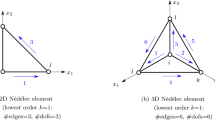Abstract
The best possible zero configurational velocity surfaces for the generalN-body problem in three space are derived. The basic construction of these surfaces is described in detail for the three body problem and for other flat configurations. The construction for nonflat configurations is outlined.
Similar content being viewed by others
References
Bozis, G.: 1976, ‘Zero velocity surfaces for the general planar three body problem,’Astrophys. Space Sci. 43, 355–86.
Easton, R.: 1971, ‘Some topology of the three body problem’.Jour. Diff. Eqs,10, 371–377.
Golubev, V.: 1967, ‘Regions where motion is impossible in the three body problem,’Soviet Physics Doklady, 527–531.
Golubev, V.: 1968, ‘Hill stability in the untrestricted three-body problem’,Soviet Physics-Doklady, 373–375.
Laskar, J. and Marchal, C.: 1984, ‘Triple close approach in the three body problem: A limit for the bounded orbits,’Celest. Mech.,32, 15–28.
Marchal, C. and Saari, D. G.: 1976, ‘On the final evolution of then-body problem’,J. Diff. Equations,20, 150–186.
Marchal, C., and Saari, D. G.: 1975, ‘Hill regions for the general three body problem’,Celest. Mech. 12, 115–129.
Palmore, J.: 1979, ‘Relative equilibria and the virial theorem’,Celest. Mech. 19, 167–171.
Saari, D. G.: 1970, ‘On bounded solutions of then-body problem’,Proceeding of International Symposium on Astronomy, Periodic Orbits, Stability and Resonances (Sao Paulo, Brazil), Reidel, 76–81.
Saari, D. G.: 1974, ‘Restrictions on the motion of the three body problem’,SIAM J. Appl. Math. 26, 806–815.
Saari, D. G.: 1976, ‘Then-body problem of celestial mechanics’,Celest. Mech. 14, 11–19.
Saari, D. G.: 1981, ‘An equality which yields zero velocity surfaces’, inThe Motion of Planets and Artificial Satellites, Ed. S. Ferraz & P. E. Nacozy, Universidade de Sao Paulo (1983), 27–39.
Saari, D. G.: 1984, ‘From rotations and inclinations to zero configurational velocity surfaces. A natural rotating coordinate system’,Celest. Mech. 33, 299–318.
Saari, D. G.: 1985, ‘Hill surfaces and the inclination of orbits’, inResonances and the Motion of Planets, Satellites, and Astroids, ed. S. Ferraz, University Sao Paulo.
Saari, D. G.: 1986, ‘Zero velocity hypersurfaces for the general three-dimensional three-body problem’,Celest. Mech.,39, 341–343.
Sergysels, R.: 1986, ‘Zero velocity hypersurfaces for the general three-dimensional three-body problem’,Celest. Mech. 36, 209–214.
Smale, S.: 1970, ‘Topology and mechanics II. The planarn-body problem,’Invent. Math. 11, 45–64.
Wintner, A.: 1941,The Analytic Foundations of Celestial Mechanics, Princeton Univ. Press.
Author information
Authors and Affiliations
Additional information
This paper is dedicated to the memory of Harry Pollard: my mentor, my collaborator, and my good friend.
Rights and permissions
About this article
Cite this article
Saari, D.G. From rotations and inclinations to zero configurational velocity surfaces, II. The best possible configurational velocity surfaces. Celestial Mechanics 40, 197–223 (1987). https://doi.org/10.1007/BF01235841
Received:
Accepted:
Issue Date:
DOI: https://doi.org/10.1007/BF01235841




